|
|
|
Sort Order |
|
|
|
Items / Page
|
|
|
|
|
|
|
| Srl | Item |
| 1 |
ID:
182694
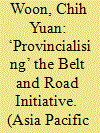

|
|
|
|
|
| Summary/Abstract |
This paper reflects on how the Belt and Road Initiative (BRI) can contribute to more cosmopolitan forms of theory-making and the diversification of knowledges. It focuses on emerging Chinese narratives of the Digital Silk Road (DSR) that cast the initiative as emblematic of an improved BRI 2.0 in the (post-)pandemic era. With subterranean fibre-optic cables and satellite systems constituting important components of the DSR, I argue that these Chinese discourses fundamentally expose the ‘horizontal’ bias in infrastructure debates, thereby forcing an analytical re-orientation towards the notion's volumetric possibilities. Reconceptualising infrastructures in volumetric terms opens up opportunities for interrogating issues of representational politics, power and sovereignty that matter for the DSR and beyond. Using Chinese perspectives of the DSR for the purpose of theory-building, however, does not equate to endorsing Sinocentrism or privileging the BRI as a totalising framework for interpreting the world. Rather, it signifies an effort to ‘provincialise’ the BRI – ensuring that different voices and subjectivities can co-exist in the ongoing and unfinished project of rethinking/reconstructing the BRI.
|
|
|
|
|
|
|
|
|
|
|
|
|
|
|
|
| 2 |
ID:
182693


|
|
|
|
|
| Summary/Abstract |
Although infrastructures may be material manifestations of state territorial power, the political effects of infrastructures are seldom straightforward. And yet, many accounts of the Belt and Road Initiative (BRI) assume a relatively conventional approach to politics, and to political power. Geopolitical intentionality and top-down policy and strategic planning tend to be emphasised over project-level analyses. In response to what might be viewed as an invented BRI geopolitics, this essay suggests a more technopolitical framing of the Belt and Road and seeks to apply an infrastructural analytic to the question of how political power is realised or frustrated, enhanced or diverted, by the distributed and relational nature of infrastructure projects. It argues that our understanding of the socio-technical complexities of infrastructure is poorly served by viewing them through a conventional geopolitical lens. Instead, it seeks to lay out a research agenda and analytical framework for addressing the questions of how infrastructure projects grow and evolve, how they are embedded within the social-political-cultural contexts in which they develop and how they produce political effects that at times align with broader-scale geopolitical agendas and at other times do not.
|
|
|
|
|
|
|
|
|
|
|
|
|
|
|
|
| 3 |
ID:
182695


|
|
|
|
|
| Summary/Abstract |
The Belt and Road Initiative (BRI) has attracted wide scholarly attention. However, discussions among social scientists on BRI have largely premised on the academic infrastructure in English language contexts. Academic research on BRI in China has often been only briefly mentioned as background information in English language publications. This disjuncture between scholarship on BRI inside and outside China reflects the multiple geographies of BRI. Thinking through BRI in English and Chinese scholarship, this paper considers how existing and future factors such as funding sources, language politics, political framing of the research and institutional surveillance may yield different intellectual spaces for understanding the knowledge production of BRI.
|
|
|
|
|
|
|
|
|
|
|
|
|
|
|
|
| 4 |
ID:
182691


|
|
|
|
|
| Summary/Abstract |
In terms of spatial imaginaries and as physical infrastructure, the Belt and Road Initiative (BRI) spurs new geographies of comparative urban study. Irrespective of whether it is the primary driver for developments carried out in its name, ‘the BRI’ is a label that serves to bring previously unassociated project sites and non-place-based infrastructural developments into comparative relation. This paper considers some of the possibilities presented by the BRI for comparative urban studies in – and from – Asia. Building upon insights from postcolonial urban studies, planetary urbanisation and inter-Asia cultural studies, I sketch two key possibilities of the BRI as (comparative urban) method. The first concerns the BRI as a series of openings to much (spatially) wider and historically deeper forms of comparison. Second, I argue that BRI as method impels forms of urban comparison beyond conventionally territorialised units of analysis at a variety of scales, including both the city and the (area studies) region.
|
|
|
|
|
|
|
|
|
|
|
|
|
|
|
|
| 5 |
ID:
182699
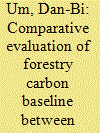

|
|
|
|
|
| Summary/Abstract |
This comparative empirical study on North Korea and Mongolia was conducted to demonstrate how satellite imagery extracted from Google Earth can be used to estimate the Reducing Emissions from Deforestation and forest Degradation (REDD) baseline. Forests in North Korea are eight times more densely distributed (8 471 787 hectares, 69.6% of its total land area) than that of Mongolia (12 842 624 hectares, only 8% of its total land area). Forests in North Korea have up to 10 times more carbon storage capacity (e.g. above-ground biomass of Pinus koraiensis under the category of the temperate continental forest, IPCC Guideline: 58.23 ton) than that of Mongolia (e.g. above-ground biomass of coniferous in boreal tundra woodland: 5 ton). Results are expected to be used as objective basic data in the process of introducing REDD+ to North Korea by verifying sharp differences between North Korea and Mongolia. The study could help companies preparing for carbon offset ventures in North Korea since it provides evidence for a more cost-effective carbon credit than in Mongolia despite less initial investment and maintenance cost for forest plantation.
|
|
|
|
|
|
|
|
|
|
|
|
|
|
|
|
| 6 |
ID:
182696


|
|
|
|
|
| Summary/Abstract |
This article investigates the impacts of the 2015 New Zealand (NZ) All Black rugby test match with Manu Samoa in Samoa: the ‘Game that stopped two nations’ (henceforth referred to as ‘the Game’). Outlining key concepts as well as events and experiences surrounding the Game, this paper reflects on how the Game aligns with the Sustainable Development Goals as well as NZ's current Pacific Reset Agenda, an agenda which aims to increase understanding, friendship, mutual benefit, collective ambition and sustainability (Ministry of Foreign Affairs and Trade, 2017). A Likert-styled questionnaire, a 15-category ranking exercise, semi-structured interviews, analysis of relevant media and other sources, informal discussions and participant observation help to provide insights into how sport for diplomacy and development functions. The Game was viewed as providing an opportunity for income generation, most participants felt excited to have shared in the experience, and many were hopeful as to what this might mean for future NZ/Samoan relations. However, we argue that, overall, this event represented a missed opportunity. If sport diplomacy events are to authentically contribute to diplomatic and development goals, more needs to be done to create meaningful and enduring engagement.
|
|
|
|
|
|
|
|
|
|
|
|
|
|
|
|
| 7 |
ID:
182697


|
|
|
|
|
| Summary/Abstract |
This paper explores the social support of Timorese workers under the Australian Seasonal Workers Programme (SWP). The SWP, which allows citizens from Pacific Island countries and Timor-Leste to work in Australian agriculture for six to nine months, has become the major source of remittances for seasonal workers from Timor-Leste. The paper describes how access to the internet and the availability of social media devices can help to maintain long-distance family relationships, support migrants' well-being and alleviate the effects of socio-spatial segregation to some extent. However, the need to earn remittances in a fixed period of time forces them to accept a trade-off in the quality of their social and personal lives in rural Australia. According to the New Economics of Labour Migration (NELM), isolation and separation from families are part of a rational household strategy to accumulate remittances. This paper argues that insufficient attention has been paid to the social costs borne by workers and left-behind households and that the sustainability of the SWP depends to a large extent on the ability of workers to find ways of meeting their needs for social support. The analysis is based on data from participant observation and semi-structured interviews with 50 Timorese seasonal workers in Australia and Timor-Leste.
|
|
|
|
|
|
|
|
|
|
|
|
|
|
|
|
| 8 |
ID:
182692
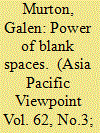

|
|
|
|
|
| Summary/Abstract |
A variety of maps depict a usefully approximate but inexact network of roads, rails, sea lanes and other infrastructures to represent something called China's Belt and Road Initiative (BRI). And yet, for a global programme that reflects and advances Beijing's new position as a leader of international development, BRI maps remain largely imprecise and unofficial. Taking this as a starting point of critical cartography, I ask why BRI development throughout the Tibet-Himalaya region remains conspicuously blank on most maps, and what work is accomplished by such cartographic silences. In contrast to this apparent invisibility, however, the BRI is very much present in Nepal – discursively, materially and cartographically. Chinese development programmes are widely anticipated, embraced and promoted as grand and spectacular things throughout Nepal. Following this friction of representation in the case of Chinese development in Nepal, I argue that the apparent paradox between the BRI as invisible thing and BRI as promised future reveals the manifold ways in which infrastructures articulate politics and, vice-versa, how politics articulate infrastructures.
|
|
|
|
|
|
|
|
|
|
|
|
|
|
|
|
| 9 |
ID:
182690
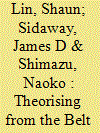

|
|
|
|
|
| Summary/Abstract |
As frame for the set that follows, this article first considers the range of theoretical interpretations of China's Belt and Road Initiative (BRI). Our focus, however, is on a related yet distinct set of questions. Rather than theorising BRI per se, we approach BRI as a source of theoretical implications and reflection – asking what it signals and implies for wider cultural, economic, political, social and urban theories, and for histories of and afterlives of imperial geopolitics.
|
|
|
|
|
|
|
|
|
|
|
|
|
|
|
|
| 10 |
ID:
182700
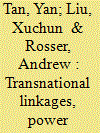

|
|
|
|
|
| Summary/Abstract |
While accepting that the migration–development nexus is best understood from a transnational perspective, recent studies analyse this nexus in a partial way rather than holistically. We review the literature, then attempt an enriched account of the complex and rapidly evolving relationship between diaspora and development in China – a country undergoing profound demographic, economic and social changes. Using in-depth interviews with a variety of key informants or stakeholders and a transnationally oriented framework, we analyse features across three core policy dimensions that incorporate both international and domestic dynamics: citizenship, top talent recruitment and soft power. Our findings contribute to the literature on Chinese-state-diaspora relations. They show that China's approach to its diaspora policy and development, practice and outcomes reaches with powerful new effects across national borders. The transnational–relational perspective gives an optimal paradigm for researchers and policymakers to understand changing strengths and complexities in interactions (contestation, conflict, negotiation, cooperation) between multi-scalar and multi-dimensional linkages, and to form diaspora policy and engagement programmes responsive to unprecedented global political, economic and social disruption.
|
|
|
|
|
|
|
|
|
|
|
|
|
|
|
|
| 11 |
ID:
182698
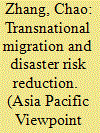

|
|
|
|
|
| Summary/Abstract |
Migrants can be disproportionately impacted by disasters due to their increased vulnerability. Knowledge of Chinese migrants' perceptions and experiences in the face of hazards and disasters is limited. This qualitative descriptive study explored Chinese migration in relation to disasters and disaster risk reduction in New Zealand. Semi-structured interviews with 22 Chinese migrants living in Auckland were conducted and data were thematically analysed. Participants displayed strong transnationalism via the creation of ‘mini-China’ and conceptions of China as their ‘mother’ country and New Zealand their ‘step-mother’ country. Chinese migrants compared their experiences of disasters in China to those in New Zealand, with many expressing difficulties with accessing information and not trusting New Zealand government authorities, particularly given how the approach contrasts to China's more ‘hands on’ approach. Fear of losing life and property and responsibility to their family were key factors underpinning Chinese migrants' decision to prepare for a disaster. Participants shared insights to guide disaster risk reduction efforts from a community level and expressed a willingness to participate in disaster preparedness organised by agencies involved in disaster risk reduction. The findings indicate capacities of Chinese migrants that planners can leverage and highlight important cultural nuances that need attention in future planning.
|
|
|
|
|
|
|
|
|
|
|
|
|
|
|
|
|
|
|
|
|